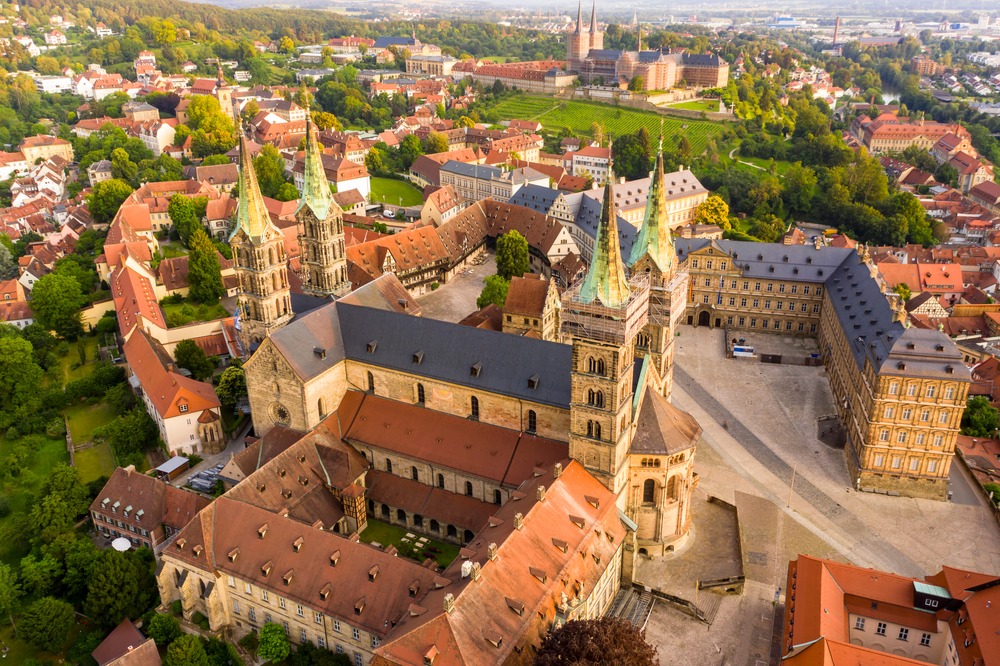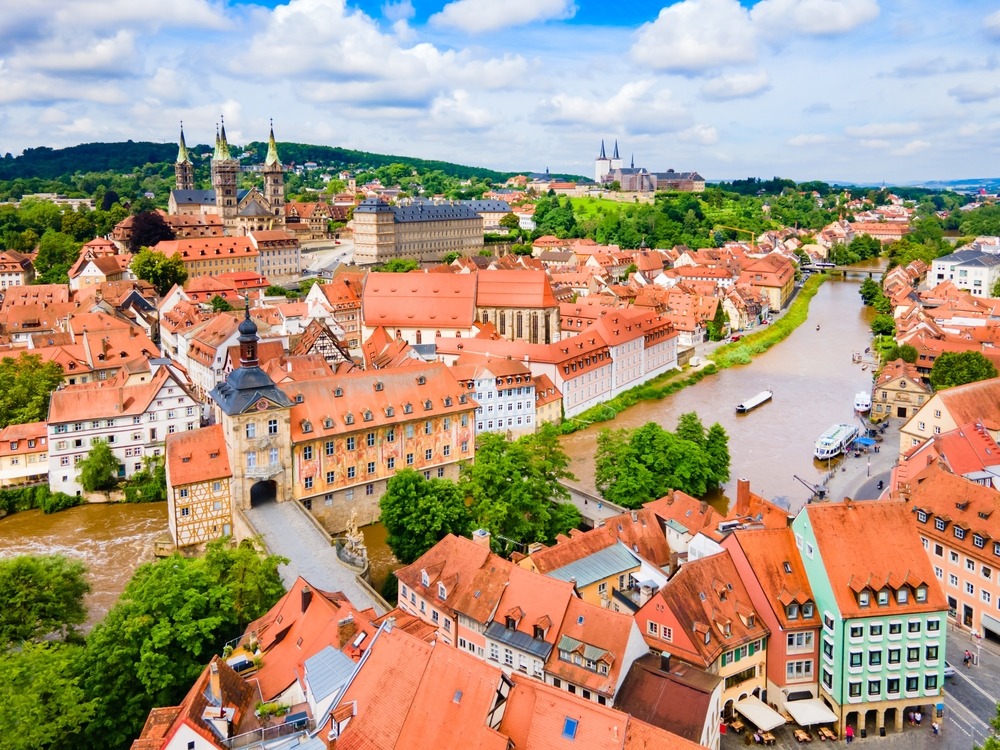Bamberg, Germany: A Tapestry of History and Heritage
The city of Bamberg, nestled along the Main River in the Upper Franconian region of Bavaria, is one of Germany’s most well-preserved historical cities. Spared from extensive bombing during World War II, Bamberg retains a medieval charm that reflects over a thousand years of architectural, cultural, and ecclesiastical evolution. Its roots trace back to the 9th century, and by the 10th century, it had emerged as a favored residence of the Babenberg family, from whom the city derives its name. Bamberg’s significance soared in 1007 when Emperor Henry II, later canonized as Saint Henry, established the Bishopric of Bamberg, aiming to spread Christianity throughout the Slavic lands.
Under Henry II’s patronage, the construction of Bamberg Cathedral began, and the city became a vital ecclesiastical and imperial center of the Holy Roman Empire. In the centuries that followed, Bamberg thrived under prince-bishops who were not only religious leaders but also worldly rulers, leaving behind a legacy of grand baroque architecture, libraries, and gardens. In the 17th and 18th centuries, Bamberg underwent a baroque transformation, echoing the grandeur of Rome—a comparison often drawn due to its seven hills, each crowned with a church.
The city’s darker chapters include the 17th-century witch trials, which were among the largest in Europe, and the tumultuous Napoleonic era, during which Bamberg was secularized and annexed by Bavaria. In the modern era, Bamberg earned international acclaim when its Altstadt (Old Town) was designated a UNESCO World Heritage Site in 1993. Today, Bamberg is a city where past and present harmonize—from its cobbled streets and timber-framed houses to its vibrant student population and cherished brewing culture.

Top 25 Attractions in Bamberg, Germany
-
Bamberg Cathedral (Bamberger Dom) – A stunning example of Romanesque architecture, this four-towered cathedral houses the tomb of Emperor Henry II and the famous Bamberg Horseman statue.
-
Alte Hofhaltung – Once the residence of the prince-bishops, this Renaissance complex features picturesque courtyards and the Historical Museum of Bamberg.
-
Neue Residenz – This baroque palace showcases lavish state rooms and offers panoramic views from the adjacent Rose Garden (Rosengarten).
-
Altes Rathaus (Old Town Hall) – One of Bamberg’s most iconic landmarks, built on an island in the Regnitz River and adorned with striking frescoes.
-
Little Venice (Klein Venedig) – A romantic row of former fishermen’s houses lining the Regnitz River, often seen by boat during city tours.
-
St. Michael’s Monastery (Kloster Michaelsberg) – Perched atop one of Bamberg’s seven hills, this former Benedictine abbey offers views of the city and houses an ornate ceiling featuring hundreds of painted medicinal herbs.
-
Historical Museum Bamberg – Located within the Alte Hofhaltung, it displays art, religious relics, coins, and items from Bamberg’s storied past.
-
Rose Garden (Rosengarten) – Located behind the Neue Residenz, the garden is renowned for its 4,500 rose bushes, symmetrical paths, and serene vistas.
-
Bamberg State Library (Staatsbibliothek Bamberg) – A research treasure trove housed in the old Jesuit college, preserving medieval manuscripts and rare books.
-
Franconian Brewery Museum (Fränkisches Brauereimuseum) – Nestled within the old monastery cellars of Michaelsberg, this museum honors Bamberg’s deep-rooted brewing traditions.
-
Schlenkerla Brewery Tavern – Home of the world-famous Rauchbier (smoked beer), this atmospheric tavern on Dominikanerstraße is a must-visit for beer lovers.
-
E.T.A. Hoffmann House (E.T.A. Hoffmann-Haus) – Dedicated to the writer and composer who lived in Bamberg, the museum details his life and surreal literary works.
-
Obere Pfarre (Church of Our Lady) – A Gothic masterpiece and the oldest parish church in Bamberg, known for its towering spire and intricate interior.
-
The Regnitz River Walks – A series of tranquil riverfront trails and footbridges that wind through Bamberg’s scenic waterways.
-
Domplatz (Cathedral Square) – A central hub surrounded by historic buildings and a popular venue for festivals and open-air events.
-
Erbainsel Park and Lock Gardens – A peaceful green space offering charming views of the river and a quiet place to relax near the city center.
-
Gärtner- und Häckermuseum (Gardeners’ and Winegrowers’ Museum) – A unique museum celebrating Bamberg’s centuries-old market gardening and viticulture heritage.
-
Villa Concordia – A baroque villa hosting international artists and events, set along the Regnitz River and offering exhibitions and performances.
-
Bamberg Symphony Orchestra (Bamberger Symphoniker) – Acclaimed worldwide, the orchestra performs regularly in the Konzerthalle Bamberg.
-
Market Square (Grüner Markt) – A bustling pedestrian zone with shops, cafés, and seasonal farmers’ markets framed by historic architecture.
-
Bamberg Nativity Trail (Krippenweg) – During Advent and Christmas, visitors can follow a trail of elaborate nativity scenes in churches and shop windows.
-
City Archaeological Trail – A series of marked locations across Bamberg’s Old Town that highlights key sites from prehistoric to medieval times.
-
St. Stephan’s Church (Stephanskirche) – Commissioned by Emperor Henry II, this was the first church in Bamberg consecrated by a pope.
-
Botanical Garden of the University of Bamberg – Tucked behind Schloss Geyerswörth, this garden is a peaceful oasis showcasing alpine, Mediterranean, and exotic flora.
-
The Old Court Brewery (Brauerei Spezial) – Another guardian of Bamberg’s brewing heritage, offering Rauchbier and Franconian fare in an authentic setting.

Bamberg is a living monument to Germany’s imperial, religious, and cultural heritage. Its layers of history unfold across centuries of preserved architecture, sacred spaces, and thriving artisan traditions—particularly in brewing, which remains a cornerstone of its identity. Whether admiring its UNESCO-listed Old Town, tracing medieval legends through its churches, or simply sipping a smoky beer in a 600-year-old tavern, Bamberg promises an unforgettable experience that balances historical gravitas with authentic local charm.

































